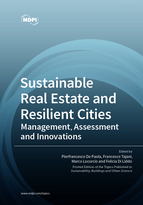Topic Menu
► Topic MenuTopic Editors




Sustainable Real Estate and Resilient Cities: Management, Assessment and Innovations

A printed edition is available here.
Topic Information
Production and consumption activities have determined a weakness of the sustainable real estate economy. The main problems are the subordination of public decision-making, which is subjected to pressure from big companies, inefficient appraisal procedures, excessive use of financial leverage in investment projects, the atypical nature of markets, income positions in urban transformations, and the financialization of real estate markets with widespread negative effects.
A delicate role in these complex problems is assigned to real estate appraisal activities, called to make value judgments on real estate goods and investment projects, the prices of which are often formed in atypical real estate markets, giving ever greater importance to sustainable development and transformation issues.
Furthermore, during recent decades, the overestimation of demographic growth has highlighted the need for urban planning processes restructuring by limiting the area’s building potential, mitigating the loss of place identity with high environmental and cultural value, and preventing uncontrolled land use, also through the valorisation and recovery of the existing heritage. In this context, economic, social and environmental demands are combined with uncertainties about the near future, related to the ongoing COVID-19 pandemic.
In the outlined framework, the focus on sustainability issues also has significant relevance in the financial sector: EU Regulation 2019/2088 requires an effort to evaluate the investments risks in relation to their ability to promote environmental and social sustainability. In this sense, the European Commission highlights the stress between a short-term approach based on the exclusive profit pursuit, and the need for long-term investment that is aimed at sustainability objectives. This is referred to as an ESG (Environmental, Social and Governance) investment rating, oriented to assess the contribution of a financial product and/or a real estate project for improving environmental, social and governance quality.
The Special Issue is dedicated, but not only limited, to developing and disseminating knowledge and innovations related to the most recent real estate evaluation methodologies applied in the fields of architecture and civil, building, and environmental and territorial engineering.
Suitable works include studies on econometric models, sustainable building management, building costs, risk management and real estate appraisal, mass appraisal methods applied to real estate properties, urban and land economics, transport economics, the application of economics and financial techniques to real estate markets, the economic valuation of real estate investment projects, the economic effects of building transformations or projects on the environment, and sustainable real estate, the analysis of the effects of COVID-19 on real estate markets dynamics and the hit on the resilient cities development processes.
Keywords
- Building management
- Building costs
- Mass appraisal methods
- Econometric models
- Real estate risk management
- Economic valuation of real estate investment projects
- Real estate market
- Social housing
- Urban economics
- Land
- Transport economics
- Real estate economics and finance
- Sustainable building transformations and economic effects on environment
- Green buildings
- Resilient cities
- COVID-19 pandemic
- Environmental, Social and Governance (ESG)
Participating Journals
| Journal Name | Impact Factor | CiteScore | Launched Year | First Decision (median) | APC |
|---|---|---|---|---|---|

Sustainability
|
3.9 | 5.8 | 2009 | 18.8 Days | CHF 2400 |

Buildings
|
3.8 | 3.1 | 2011 | 14.6 Days | CHF 2600 |

Urban Science
|
2.0 | 4.5 | 2017 | 23.7 Days | CHF 1600 |

MDPI Topics is cooperating with Preprints.org and has built a direct connection between MDPI journals and Preprints.org. Authors are encouraged to enjoy the benefits by posting a preprint at Preprints.org prior to publication:
- Immediately share your ideas ahead of publication and establish your research priority;
- Protect your idea from being stolen with this time-stamped preprint article;
- Enhance the exposure and impact of your research;
- Receive feedback from your peers in advance;
- Have it indexed in Web of Science (Preprint Citation Index), Google Scholar, Crossref, SHARE, PrePubMed, Scilit and Europe PMC.

